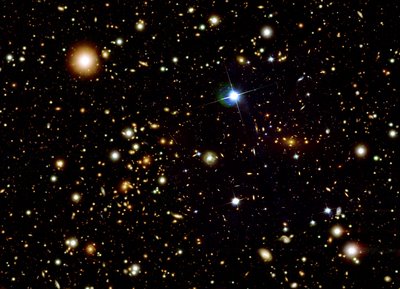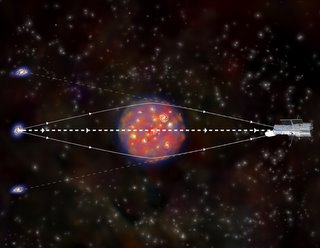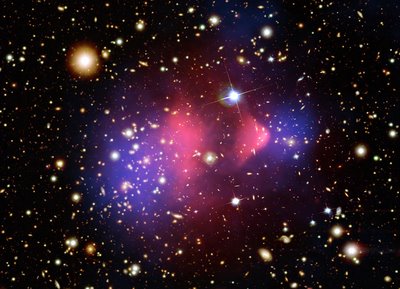03 September 2006
23 August 2006
Dark matter revealed in the collision of galactic clusters
The biggest recent news in astronomy is not Pluto but the fact that dark matter is clearly revealed in collisions of galactic clusters. This point is emphasized by Sean Carroll in Cosmic Variance who gives a nice exposition of how the a combination of information from gravitational lensing and X-ray pictures of the bullet cluster helped to nail down the elusive dark matter.

These pictures depict the collisions of the bullet cluster
(1E 0657-56), moving to the right colliding with a much large cluster of galaxies. When clusters of galaxies collide, the dark matter in each shown in blue moves on unaffected while the normal matter shown in pink gets deflected due to electromagnetic interactions.
This illustration was put together by combining the optical pictures from Magellan and Hubble telescopes with the x-ray observation with the Chandra space telescope.
This is picture in optical wavelegths of the galaxies which lie behind the bullet cluster.

To the expert 'eye' there is an evident duplication and distortion in the shape of these galaxies which can only be due to the lensing of these galaxies by a unseen distribution of mass in the foreground.

Using the lensing theory one can reconstruct the distribution of the unseen matter in the foreground which turns out to be two sperical mass distribution close to the bullet cluster and its companion.

Most of the normal mattter in the galactic clusters is not in stars but in the interstellar and intergalatic gas (mainly hydrogen and helium). This gas scatters light in the form of X-rays due to its high velocity. After 140 hours of observations with the Chandra X-ray telescope this is the picture that emerges of the visible matter near the bullet cluster

Now superimposing the distribution of normal matter as seen in the X-ray observations with the dark matter distribution
as inferred from lensing, the following startling picture
emerges
 (Credit: X-ray: NASA/CXC/CfA/M.Markevitch et al.; Optical: NASA/STScI; Magellan/U.Arizona/D.Clowe et al.; Lensing Map: NASA/STScI; ESO WFI; Magellan/U.Arizona/D.Clowe et al.)
(Credit: X-ray: NASA/CXC/CfA/M.Markevitch et al.; Optical: NASA/STScI; Magellan/U.Arizona/D.Clowe et al.; Lensing Map: NASA/STScI; ESO WFI; Magellan/U.Arizona/D.Clowe et al.)
The normal visible matter in each cluster is offset from the actual mass distribution! The dominant mass in each cluster must be in some weakly interacting form of matter which did not get deflected in a collision which is inferred to have occured 150 million years earlier.
There has long been evidence of dark matter in the galaxies- as the rotation speed of the gas in the periphery is much larger than what would be supported by the gravitational attraction of the visible matter.
One theory for explaning this anomaly was MOND- modifying Newtonian dynamics- or the theory of gravity at the distance of galaxies
instead of introducing dark matter.
With this observation MOND is ruled out.
Details can be found in this paper. They give an upper limit on the self-interaction cross section of dark mattter to be
sigma/m < 1 cm^2/gm
which also rules out the strongly self-interacting dark matter theory .

These pictures depict the collisions of the bullet cluster
(1E 0657-56), moving to the right colliding with a much large cluster of galaxies. When clusters of galaxies collide, the dark matter in each shown in blue moves on unaffected while the normal matter shown in pink gets deflected due to electromagnetic interactions.
This illustration was put together by combining the optical pictures from Magellan and Hubble telescopes with the x-ray observation with the Chandra space telescope.
This is picture in optical wavelegths of the galaxies which lie behind the bullet cluster.

To the expert 'eye' there is an evident duplication and distortion in the shape of these galaxies which can only be due to the lensing of these galaxies by a unseen distribution of mass in the foreground.

Using the lensing theory one can reconstruct the distribution of the unseen matter in the foreground which turns out to be two sperical mass distribution close to the bullet cluster and its companion.

Most of the normal mattter in the galactic clusters is not in stars but in the interstellar and intergalatic gas (mainly hydrogen and helium). This gas scatters light in the form of X-rays due to its high velocity. After 140 hours of observations with the Chandra X-ray telescope this is the picture that emerges of the visible matter near the bullet cluster

Now superimposing the distribution of normal matter as seen in the X-ray observations with the dark matter distribution
as inferred from lensing, the following startling picture
emerges
 (Credit: X-ray: NASA/CXC/CfA/M.Markevitch et al.; Optical: NASA/STScI; Magellan/U.Arizona/D.Clowe et al.; Lensing Map: NASA/STScI; ESO WFI; Magellan/U.Arizona/D.Clowe et al.)
(Credit: X-ray: NASA/CXC/CfA/M.Markevitch et al.; Optical: NASA/STScI; Magellan/U.Arizona/D.Clowe et al.; Lensing Map: NASA/STScI; ESO WFI; Magellan/U.Arizona/D.Clowe et al.)The normal visible matter in each cluster is offset from the actual mass distribution! The dominant mass in each cluster must be in some weakly interacting form of matter which did not get deflected in a collision which is inferred to have occured 150 million years earlier.
There has long been evidence of dark matter in the galaxies- as the rotation speed of the gas in the periphery is much larger than what would be supported by the gravitational attraction of the visible matter.
One theory for explaning this anomaly was MOND- modifying Newtonian dynamics- or the theory of gravity at the distance of galaxies
instead of introducing dark matter.
With this observation MOND is ruled out.
Details can be found in this paper. They give an upper limit on the self-interaction cross section of dark mattter to be
sigma/m < 1 cm^2/gm
which also rules out the strongly self-interacting dark matter theory .
The problem is with Jupiter not Pluto
 (Picture credit:IAU-Martin Kornmesser)
(Picture credit:IAU-Martin Kornmesser)Lord Raleigh is supposed to have said "Physics is the only science, all the rest is stamp collecting". This normally not-to-be-taken-seriously type of remark seems to apply to the august gathering (oh! there's a pun here) of the members of IAU in Prague whose sole purpose -or so it seems- is to classify the bodies in our solar system as planets or non-planets.
One camp wants to promote Ceres (currently an asteroid but which used to be a planet in 19th century) , the newly discovered UB313 (a.k.a. Xena) and Pluto's moon Charon to the status of planets. The other camp would like to demote Pluto and lump it with these three bodies and call them all dwarf planets.
Meanwhile there is real long standing question about planets which remains unanswered. It is known that Jupiter emits 70% more light than what it gets from the sun.
What is the source of this energy? A gasseous planet must have minimum mass of 1.8 times Jupiter's mass before the hydrogen fusion can take place in its core (the planet then turns into a star). So where does Jupiter get this excess energy since it is too puny to be a star? Thats a real physics question.
The news from the IAU gathering is that the division between the two camps is right down the midddle and the issue will be settled by votes later today and Pluto's fate hangs by a thread.
Yawn...




